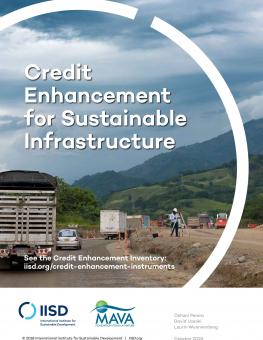
Credit Enhancement for Sustainable Infrastructure
The paper identifies the demand and supply-side barriers for upscaling credit enhancement solutions for sustainable infrastructure projects.
As a part of the IISD Global Survey on Credit Enhancement, we conducted interviews with users and providers of credit enhancement instruments, including multilateral development banks, development finance institutions, export credit agencies, private guarantors and other de-risking facilities.
Our objective was to find answers to the following questions:
- Why do we not see more infrastructure deals taking advantage of credit enhancement solutions?
- What can be done to increase the use of credit enhancement instruments?
- Do we need more instruments? If yes, which project risks should they address?
IISD has started this project with the hypothesis that the answers to these questions lie in the lack of public sector expertise in planning and preparing infrastructure projects. Financial structuring is the primary responsibility of the financial advisors to the public sector, but governments also need to have a general understanding of the de-risking
solutions available to them. How else can they instruct their advisers and negotiate with donors and private financiers on the cost of capital? Moreover, how can they integrate this into their preliminary financial viability assessments and raise it with the relevant parties throughout the procurement and financial structuring processes?
Our research confirms that, while this hypothesis is correct, the reasons behind the limited uptake of credit enhancement are complex.
Participating experts
You might also be interested in
The Role of Multilateral Development Banks for Low-Carbon Procurement in the Infrastructure Sector
This report examines the critical role of multilateral development banks (MDBs) in advancing low-carbon procurement within the infrastructure sector.
Credit Enhancement for Green Projects
Risk mitigation is key to securing private financing. The credit enhancement method provides a medium wherein the exposure for the lending institution is comparatively less and the benefits for the recipient borrower are high.
Sustainable Asset Valuation (SAVi) of a Small-Scale Tree Planting Initiative in Côte d'Ivoire
This report analyzes the social, economic, and environmental outcomes of a small-scale tree planting initiative at schools in Côte d'Ivoire.
Green Public Procurement in India
This report analyzes the status of green public procurement (GPP) in India and suggests key strategies for advancing sustainable procurement practices.